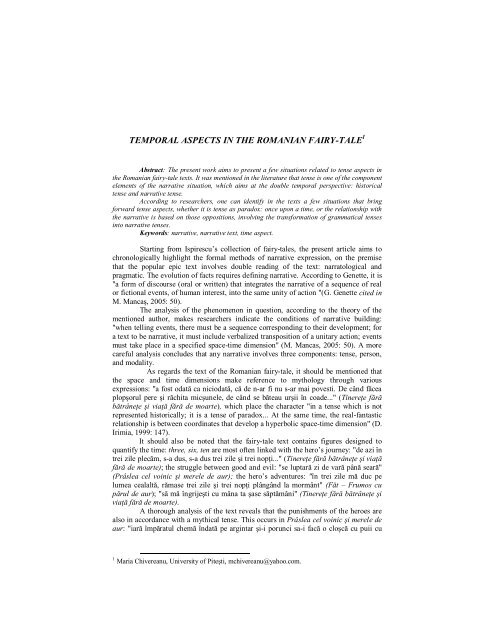language and literature european landmarks of identity
language and literature european landmarks of identity
language and literature european landmarks of identity
You also want an ePaper? Increase the reach of your titles
YUMPU automatically turns print PDFs into web optimized ePapers that Google loves.
TEMPORAL ASPECTS IN THE ROMANIAN FAIRY-TALE 1<br />
Abstract: The present work aims to present a few situations related to tense aspects in<br />
the Romanian fairy-tale texts. It was mentioned in the <strong>literature</strong> that tense is one <strong>of</strong> the component<br />
elements <strong>of</strong> the narrative situation, which aims at the double temporal perspective: historical<br />
tense <strong>and</strong> narrative tense.<br />
According to researchers, one can identify in the texts a few situations that bring<br />
forward tense aspects, whether it is tense as paradox: once upon a time, or the relationship with<br />
the narrative is based on those oppositions, involving the transformation <strong>of</strong> grammatical tenses<br />
into narrative tenses.<br />
Keywords: narrative, narrative text, time aspect.<br />
Starting from Ispirescu’s collection <strong>of</strong> fairy-tales, the present article aims to<br />
chronologically highlight the formal methods <strong>of</strong> narrative expression, on the premise<br />
that the popular epic text involves double reading <strong>of</strong> the text: narratological <strong>and</strong><br />
pragmatic. The evolution <strong>of</strong> facts requires defining narrative. According to Genette, it is<br />
"a form <strong>of</strong> discourse (oral or written) that integrates the narrative <strong>of</strong> a sequence <strong>of</strong> real<br />
or fictional events, <strong>of</strong> human interest, into the same unity <strong>of</strong> action "(G. Genette cited in<br />
M. Mancaş, 2005: 50).<br />
The analysis <strong>of</strong> the phenomenon in question, according to the theory <strong>of</strong> the<br />
mentioned author, makes researchers indicate the conditions <strong>of</strong> narrative building:<br />
"when telling events, there must be a sequence corresponding to their development; for<br />
a text to be narrative, it must include verbalized transposition <strong>of</strong> a unitary action; events<br />
must take place in a specified space-time dimension" (M. Mancas, 2005: 50). A more<br />
careful analysis concludes that any narrative involves three components: tense, person,<br />
<strong>and</strong> modality.<br />
As regards the text <strong>of</strong> the Romanian fairy-tale, it should be mentioned that<br />
the space <strong>and</strong> time dimensions make reference to mythology through various<br />
expressions: "a fost odată ca niciodată, că de n-ar fi nu s-ar mai povesti. De când făcea<br />
plopşorul pere şi răchita micşunele, de când se băteau urşii în coade..." (Tinereţe fără<br />
bătrâneţe şi viaţă fără de moarte), which place the character "in a tense which is not<br />
represented historically; it is a tense <strong>of</strong> paradox... At the same time, the real-fantastic<br />
relationship is between coordinates that develop a hyperbolic space-time dimension" (D.<br />
Irimia, 1999: 147).<br />
It should also be noted that the fairy-tale text contains figures designed to<br />
quantify the time: three, six, ten are most <strong>of</strong>ten linked with the hero’s journey: "de azi în<br />
trei zile plecăm, s-a dus, s-a dus trei zile şi trei nopţi..." (Tinereţe fără bătrâneţe şi viaţă<br />
fără de moarte); the struggle between good <strong>and</strong> evil: "se luptară zi de vară până seară"<br />
(Prâslea cel voinic şi merele de aur); the hero’s adventures: "în trei zile mă duc pe<br />
lumea cealaltă, rămase trei zile şi trei nopţi plângând la mormânt" (Făt – Frumos cu<br />
părul de aur); "să mă îngrijeşti cu mâna ta şase săptămâni" (Tinereţe fără bătrâneţe şi<br />
viaţă fără de moarte).<br />
A thorough analysis <strong>of</strong> the text reveals that the punishments <strong>of</strong> the heroes are<br />
also in accordance with a mythical tense. This occurs in Prâslea cel voinic şi merele de<br />
aur: "iară împăratul chemă îndată pe argintar şi-i porunci sa-i facă o cloşcă cu puii cu<br />
1 Maria Chivereanu, University <strong>of</strong> Piteşti, mchivereanu@yahoo.com.


